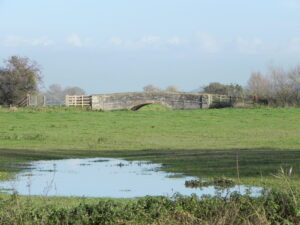Knapp Bridge

| Bridge Name: | Knapp Bridge | |||
| No.: | 82 | |||
| Location: | Knapp | |||
| Build Date: | Circa 1816 | |||
| Engineer: | Possibly James Hollinsworth | |||
|
© Copyright somersetrivers.org |
||||
| Description: | ||||
| Road bridge. Single span, semi-circular arch, string course, end pilasters, hump backed bridge. Squared and coursed blue lias, saddle back Ham stone coping and Ham stone voussoirs.1
Replaced a timber bridge. For the new bridge they engaged the services of John Easton, a surveyor from Bradford on Tone, and the son of the well known surveyor, Josiah Easton. He was to work with his brother, William, from Hillfarrance, on erecting a new, single span, stone bridge, similar in design to the one built 60 years earlier at ‘New Bridge’. Pibsbury stone was again specified, but with two rings ‘in the arch in Hamden Hill stone’. For this work they were paid �380. Today, this elegant bridge still stands in splendid isolation on the moors, for the trackway is not used to the extent it once was. It is surprisingly good condition, considering the minimal maintenance it would have received over the intervening years, testimony to the high quality of craftsmanship that the Conservators brought to bear upon the work they undertook.2 The original Knapp Bridge was located downstream in the location of the current New Bridge On the petition of the inhabitants of North Curry concerning a bridge in their parish called Knapp Bridge, which is very ruinous and likely to fall into utter decay without speedy prevention ; the Court orders that an assessment be made in the said parish as above [last entry], and appoints Giles Foster and Michael Potter, churchwardens of the parish, to be the collectors thereof.3 |
||||
| References: | 1./www.tauntondeane.gov.uk/tdbcsites/her/her_lb/lbdets.asp?id=000005″>Taunton Deane B C������ � 2. By Waterway to Taunton – Tony Haskell 3. Quarter Sessions 11 July, 23 Charles II. [1671.] Somerset Record Society v34 Also in The Ancient Bridges of the South of England by E.Jervoise published in 1930 |
|||
